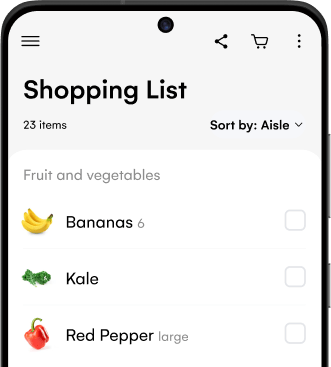Estimated reading time: 7 minutes
Years ago, we were worried about eating too much fat. Recently, carbohydrates have become the food group we’re suspicious of. But though you’ll receive conflicting advice from all corners, health experts are increasingly challenging the idea that one food group should be excluded from a healthy diet.
Instead, there’s a growing focus on fuelling your body with the right balance of protein, fat, and carbs for your goals. Casually, we refer to this balance as your ‘macros.’ So what does that mean and how do you find the right ratios for you?
What are macros?

The word ‘macros’ is short for ‘macronutrients.’ You might have seen hashtags like #ifitfitsyourmacros or #IIFYM on social media. Broadly though, macros is a term used to describe the three key food groups you require for your body to function.
Plan meals together! Share this plan with your family

These three groups are carbohydrates, fats, and proteins. Previously the domain of bodybuilders and dieticians, learning how to effectively count your macros is becoming a more common strategy for everyday people to meet their body composition goals. Why? Because it’s effective.
Before we get to the right ratios for your body composition goals, let’s look at each of the macronutrients and their role in health and nutrition.
Why does your body need carbohydrates?

Carbohydrates get a lot of hate from the weight loss community. But they’re an essential part of a healthy and balanced diet. Carbohydrates come in three forms: starches, fiber, and sugar, all of which are metabolized and used slightly differently by the body.
Each type of carb is digested in different paces by the body. This may differ whether the carbohydrate has more sugar in it (which is digested faster), or if the carbohydrate source is complex and has more fiber (which takes more time to digest). But as an end product, most of them are turned into glucose or simple sugar, which you then store in your liver and muscles as glycogen. This serves as an immediate source of energy that your body uses for energy during high intensity exercise which in turn helps you to burn fat and build muscle.
Why does your body need fat?

Fat is seen as the enemy all too often. And for many people, reducing body fat percentage is a health goal. But keep in mind that completely eliminating fat from your diet and having too low of a body fat percentage can cause serious health problems. Fat is required to help your body absorb certain fat-soluble vitamins like A, D, E, and K. It is also a source of essential fatty acids, like omega-3, which your body can’t make itself.
Fat protects bones and organs, promotes nerve and brain health, and acts as a backup source of energy (after carbohydrates).
As far as your diet goes, fat also helps you feel full which can help prevent you from reaching for the snack jar and consuming too many calories.
Why does your body need protein?

Protein is the building block of all muscles. It’s a source of amino acids, which are crucial for key bodily functions like nutrient absorption. Nine of these amino acids are considered essential amino acids which your body can’t make. Instead, you must get them from food – sources of protein specifically.
Protein does provide some energy, but is particularly important in muscle building and repair, especially after exercise. And in addition to this, it is also a vital nutrient in maintaining a strong immune system.
What balance of protein, fat, and carbs do I need?
Striking the right balance of these macros can help you to meet your body composition goals – whether that’s losing weight, building muscle, or maintaining your current balance.
The magic ratio isn’t a one size fits all solution though. The right balance depends on your age, size, and activity level. And because we all have different goals and circumstances, we all have to take slightly different paths to reach our body goals.
For instance, your activity level impacts the amount of carbs you need. And it can also affect your performance as an athlete. The ratio of carbohydrates to protein and fat you need can vary depending on your physical activity and type of training. And if you’re looking to build muscle, you need to eat sufficient protein. Added to that, it isn’t just the percentages or ratios which matter when it comes to your macro balances. It’s also the total amount. It’s also about your overall calorie consumption and ensuring you’re consuming enough total calories to fuel your daily activities and workouts.
It’s good to keep in mind that your needs might be different to someone else’s, even if you have the same overall goal (e.g. losing fat). In general though, these ratios are a good place to start.

Macros for losing weight and burning fat
There are plenty of different ratios which people follow to lose weight. You’ve probably seen people promoting low-carb diets, keto diets, or even vegan diets.
However, the most commonly recommended ratios from the AMDR (Acceptable Macronutrient Distribution Range) are 45-65% carbohydrates, 10-30% protein, and 25-35% fat. The exact percentage which works for you will depend on your health and activity level. And of course, you’ll need to be in a calorie deficit which usually means reducing your calories by 10-20%.
Macros For gaining muscle (bulking)
Bulking or gaining weight might conjure up images of eating as much pizza as you can handle, but that’s not the healthiest or most efficient way to gain muscle. Although it is an effective strategy to gain body fat.
If you’re looking to build lean muscle, a good starting point is to consume 1.2 g – 1.4 g of protein per kilogram of body weight. You may also need to increase your overall calorie consumption by 10-20% from your maintenance calories if your body fat percentage is within a normal, healthy range. Of course, you would also need to combine this with an exercise regime which promotes building muscle.
Create your own recipes from scratch

Macros for maintaining weight
If you’re happy with your current muscle mass and body weight, you might simply want to maintain it. The right ratio of protein, fat, and carbs will depend on your current activity level and other factors. For instance, a fit marathon runner will need different macros to maintain their body composition than an average person. Or indeed, a weightlifter.
However, a healthy macro breakdown could be anywhere in the range of:
- 45-65% carbs
- 10-30% protein
- 25-35% fat
Healthy carbohydrates, proteins, and fats to help you meet your macros

Regardless of your goals, it’s always best to choose nutritionally balanced foods in each of the macronutrient categories as often as you can. Though you could meet your carb goals with white bread, for instance, you’ll see better results if you opt for whole grain options.
Here are some foods which are great sources of protein, fat, and carbs:
- Carbohydrates: Whole Grain bread, whole grain pasta, brown rice, legumes, potatoes, and fruit.
- Proteins: chicken breast, turkey, lean cuts of beef like fillet and extra-lean ground beef, fatty fish, egg whites, tofu, and chickpeas.
- Fats: Satiating, healthy fats include olive oil, avocado, nuts, fatty fish like salmon, and seeds.
Recipe ideas with a good balance of protein, fat, and carbohydrates
Breakfast: Peanut butter overnight oats
Make a bowl of overnight oats that’s indulgent yet healthy with creamy peanut butter and tangy raspberries. Or make it in a jar and take it to work

Lunch: Chicken & chorizo jambalaya
A healthy Cajun-inspired rice pot recipe that’s bursting with spicy Spanish sausage, sweet peppers and tomatoes.

Dinner: Creamy smoked salmon and lemon pasta
Succulent smoked salmon and zingy lemon transform this simple pasta dish into something really special

Snacks: Steamed bao buns
Fill these steamed Chinese bread rolls with BBQ pork and pickled vegetables for a perfect Chinese New Year party nibble





